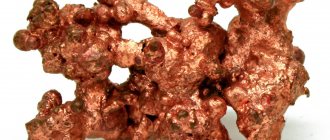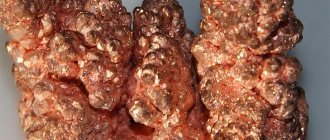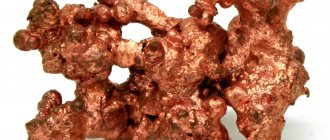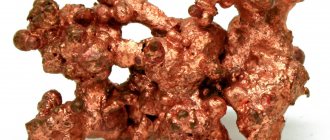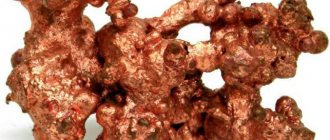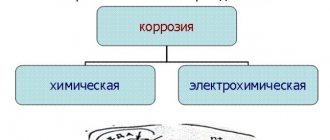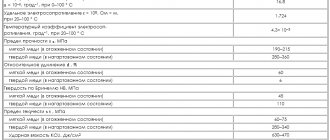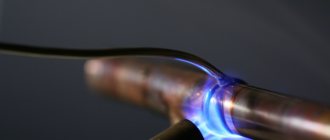Unique properties
Nowadays, there are many different metals and alloys. So in conclusion, I would like to say why copper material with the addition of beryllium is most valued in the above areas. So this alloy:
- Really elastic. It will literally “spring”.
- Very durable. It will retain its original hardness and appropriate appearance for decades.
- Easily amenable to “improvement”. The tensile strength is 450 MPa, but it can be increased by 40% only by subjecting it to deformation, which was mentioned earlier. But in general it is possible to bring it up to 1400 MPa.
- It does not change its properties, even if it is heated to 340 °C. If you increase the temperature to 500 °C, then its qualities will become similar to those characteristic of aluminum, phosphorus, and tin alloys.
By the way, to make beryllium material even stronger, boron, magnesium, titanium, nickel, cobalt or rare earth metals are sometimes added to it. In certain cases, such impurities are acceptable and justified.
Advantages and disadvantages
The alloy in question has been popular for many years. Over the years, its relevance has not decreased, which is due to the many advantages that it has. Let's look at the main positive characteristics of bronze that make it in demand.
- This metal boasts a rich variety. There are many different types of bronze, such as tin, silver, aluminum and many other varieties that have their own formulas and features. Such materials prove useful in various fields; they contain various elements that affect the physical properties and operating characteristics of the metal.
- Existing bronze alloys are divided into casting and wrought subtypes. That is, in order to solve “your” specific problems, it is possible to obtain a metal that will easily lend itself to cold forging - a process of deformation at normal temperature values. It will also be possible to obtain an alloy that can be cast.
- A significant advantage is that high-quality castings from the alloy in question demonstrate the smallest shrinkage - only 0.5-1.5%. This property determines the wide distribution and demand of the material not only among professional sculptors, but also in the manufacture of special industrial machines and instruments.
- Bronze is a material that can be used several times. The alloy can easily withstand further remelting if necessary. This procedure does not harm the material and does not have a negative impact on its properties.
- One of the most important advantages of bronze is that it is safe and environmentally friendly. If during the production of such an alloy potentially dangerous components were involved, for example, beryllium, then the finished product will still not be toxic. Today, not every material can boast of such important qualities.
- Bronze alloy has high corrosion resistance. Neither urban polluted air nor sea water can negatively affect it. Under the influence of such external factors, the material does not deteriorate and does not lose its former attractiveness. Bronze is not at all afraid of most acids and is not subject to their negative effects. That is why this material is often used for the production of special acid-resistant equipment.
- Bronze has another interesting quality - it is elastic. The alloy is in many cases used for the manufacture of various high-precision spring parts that are designed for long service life.
Despite the impressive list of advantages, the bronze alloy is still not without certain disadvantages. The main one is the cost of practical material. Copper, and even more so tin, are materials that are used in many situations, but they are expensive to obtain.
The disadvantages of the bronze alloy include not the highest thermal conductivity. However, this distinctive feature could also find its application - for example, in the production of various bathroom accessories.
Basic parameters
BrB2 is the most widespread type of beryllium bronze. This material contains beryllium, which provides it with high hardness - up to 400 Brinell units. But, it should be noted that such high hardness is inherent in the alloy, which went through artificial aging at a temperature of 300 - 350 degrees Celsius.
Beryllium bronze has high strength and resistance to various chemicals. In addition, the alloy has good weldability. The set of these properties allows the use of beryllium bronze in various industries, for example, in electrical engineering; elements of contact groups, springs, and various types of membranes are produced from it. Unfortunately, beryllium is quite expensive and this prevents the mass use of this material.
The mass volume of beryllium in such an alloy ranges from 1.5 to 3%, the rest is occupied by copper. However, there are alloys that contain cobalt or nickel. The first is called copper-cobalt, it is called ICD. The second is called copper-nickel and is designated MNB. In these grades the volume of beryllium does not exceed 0.8%. MKB and MNB are classified as low-alloy compounds.
Meanwhile, there is such a brand as BrV2.5. The mass fraction of alloying additives in it is 2.5%, and this allows it to be classified as highly alloyed.
There are also imported materials bearing the following markings:
- CuCo2Be, alloy 10, C17500;
- CuNi2Be, alloy 11, C17510.
Beryllium bronzes have the following property - when heated to certain temperatures, the alloying additives included in their composition begin to dissolve. That is, during heat treatment (hardening), the concentration of alloying components increases. As a result, the formation of a so-called saturated solution occurs, which, by the way, has low stability. The whole point is that it (the solution) can retain the basic properties that arose during its appearance. If any parameters change, for example, temperature, the solution begins to disintegrate into its component parts. Moreover, when heated, in accordance with the laws of thermodynamics, the decomposition process accelerates. When the solution decomposes, elements of different sizes are formed, and it is on their presence that the strengthening effect achieved during the hardening process depends. This is called dispersion strengthening.
The key parameter of heat treatment is temperature. When processing copper-beryllium alloy, it lies within 775 ºC. This treatment leads to an increase in tensile strength from 450 to 1400 MPa. In addition, the parts receive additional plasticity.
News
Beryllium bronzes belong to the class of so-called dispersion-hardening alloys, a characteristic feature of which is the dependence of the solubility of alloying components on temperature. When quenching from a single-phase region, an excess number of atoms of the alloying component is fixed in the solid solution compared to the equilibrium state for a given system. The resulting supersaturated solid solution is thermodynamically unstable and tends to decompose; the process is activated with increasing temperature. The hardening effect is determined by the dispersion of the precipitates formed during decomposition.
The most used alloys of the Cu-Be system are the BrB2 alloy (CuBe2, alloy 25, C 17200 according to foreign specifications) containing about 2% beryllium, as well as MNB alloys (copper-nickel-beryllium or CuNi2Be, alloy 11, C17510 according to foreign specifications) and MKB (copper-cobalt-beryllium or CuCo2Be, alloy 10, C17500 according to foreign specifications), containing up to 0.8% beryllium. The BrB2 alloy is also called high-alloy beryllium bronze, and the MNB and MKB alloys are called low-alloy beryllium bronze.
The listed alloys in the hardened state have good ductility and manufacturability, as well as high mechanical properties in the heat-treated (aged) state. An additional increase in the level of mechanical properties can be achieved by plastic deformation before aging (PTSD).
The listed features underlie the use of beryllium bronzes in industry. A semi-finished product made of beryllium bronze in a hardened or hardened and deformed state can be turned by stamping methods into a product of the most complex shape: a bearing support , spring contact, connector, membrane and, after aging, dramatically increase the strength and spring properties of this product, while maintaining its shape.
Application areas of beryllium bronzes
The use of beryllium bronzes is highly effective in cases where it is required:
- high electrical conductivity;
- high thermal conductivity;
- high strength and elastic properties;
- high corrosion resistance;
- the material lacks the ability to spark during impacts and has no ferromagnetic properties;
Instrumentation. Electronics. Means of communication and communication
The largest application of copper-beryllium alloys is their use in electrical and electronic parts, primarily in spring contacts, switches, connectors, as well as in fiber optic telecommunications equipment, socket connectors for connecting integrated circuits to printed circuit boards. The continued increase in complexity of computer technology and mobile devices is a major factor leading to the miniaturization of electronic parts. This leads to an increase in demand for copper-beryllium alloys, i.e. these parts require smaller, lighter, and more reliable connectors. Communicators, smart phones, mobile phones, tablets, laptops and other modern mobile devices contain many critical parts made of beryllium bronze.
Automotive industry.
Electronic parts containing copper-beryllium alloys. used in engine compartment components and electronic circuits of vehicle security systems.
The production and degree of computerization of cars is growing. This is leading to an increase in the use of beryllium bronzes in the automotive industry.
Drilling equipment and oil production equipment
Here, such properties of beryllium bronzes are used as high strength and anti-friction, corrosion resistance, and the ability not to form a spark. BrB2 alloy is used to make sliding bearings for oil pumps, drill bit supports , pipes, threaded connections of drill pipe strings, and non-sparking auxiliary tools.
contact welding
Due to high strength, good heat resistance and electrical conductivity, electrodes and electrode holders made of low-alloy beryllium bronze are widely used in resistance welding. The service life of these electrodes significantly exceeds the corresponding indicator for electrodes made of BrH bronzes. and BrKhTsr. (chrome bronzes) for spot welding of construction reinforcement, wire, carbon steel sheets, BrNHK (nickel-chrome-silicon bronze), MH2.5KoKr alloy for spot welding of wire, reinforcement, butt welding of sheet steel, welding of rails for main railway tracks, etc. .P.
Casting of metals and alloys
Beryllium bronzes are successfully used in plungers (pistons) of injection molding equipment , incl. aluminum, chill molds for casting various metals and alloys , in the walls of molds of casting machines and continuous casting plants . Here, the advantages of beryllium bronze are the increased service life and the absence of the need to apply an expensive protective coating to the walls of crystallizers and casting molds.
Aircraft manufacturing. Mechanical engineering
Beryllium bronzes in these industries are used for the manufacture of critical parts of devices and machines that are subject to the combined effects of high variable loads and variable temperatures. Thus, in modern aircraft, beryllium bronze is used in the manufacture of most instruments, as well as landing gear elements, etc.
This is not a complete list of areas of application of copper-beryllium alloys. As industry develops, new areas of their application appear, and new beryllium-containing alloys are developed.
Types of bronze and their applications
With the development of metallurgy and the discovery of different types of metals, a large number of bronzes appeared, but the main metal in the formula is copper. Depending on what components are included in the composition, the properties of the material also change.
Knowledge of these features allows the use of bronze alloys in various types of industry, depending on the requirements for the material. Bronze is often produced in the form of rolled tubes, wires and sheets. Metal is used in the production of bearings, bushings, springs and other parts subject to high pressure and wear. High anti-corrosion properties allow this material to be used also in aggressive environments and when working with various chemicals. In addition, the use of bronze is widespread in artistic forging and casting; various sculptures, monuments and decorations are made from it.
Tin
An alloy of copper and tin is called tin. These bronzes were used in the Bronze Age, have survived to this day and are the most used in industry. Various bells were often cast from this type of alloy, which is why this material is sometimes called bell bronze.
Tin material is almost impossible to machine, so products from it are created exclusively by casting; has high hardness and strength, as well as anti-corrosion properties. The standard alloy of copper and tin is characterized by a quantitative ratio of 80:20, but can be supplemented with certain metals to change the properties:
- The addition of zinc (less than 10%) increases the anti-corrosion resistance. Used to create parts that need to be in frequent contact with water and other oxidizing agents.
- Lead and phosphorus increase anti-friction properties. In addition, an alloy with the addition of these metals is easier to process.
Sometimes the presence of tin in a product is unacceptable and it is replaced with other metals that achieve the required characteristics, for example, lead, silicon, zinc, beryllium or aluminum. Such bronze is called tin-free, or special.
Lead
The main alloying component is lead, the content of which can reach 30%. The material has good anti-friction properties and high thermal conductivity, can withstand pressures of up to 30 mPa, and is therefore used for the manufacture of bearings exposed to high pressure.
Silicon-zinc
This alloy consists of 97% copper, 1.1% tin, 0.05% silicon and zinc. It is quite plastic and fluid, which allows it to be used as a material in products of complex shapes. It has good compression resistance, anti-friction properties and elasticity. It does not spark during processing, has good resistance to low temperatures, and often contains nickel and manganese additives.
Beryllium
Beryllium alloy is the hardest of all existing types of bronze. It has high anti-corrosion properties, does not spark during processing, and is not magnetic. During the hardening process, it acquires good deformability and elasticity.
Aluminum
The percentage composition of bronze looks like 95% copper and 5% aluminum. The alloy resists aggressive environments very well, is heat-resistant, but has low anti-corrosion properties and exhibits severe shrinkage.
An alloy of copper with zinc is called red bronze - brass, and with nickel - cupronickel. These compounds are individual materials and small amounts may be present in any alloy, but must be less than the sum of all other components.
Properties and applications of beryllium bronzes
Beryllium bronze
Beryllium bronze is an alloy of copper and beryllium that has been subjected to precipitation hardening. This material has found wide application in the manufacturing process of parts with various purposes, including those intended for installation in particularly critical products, which is primarily due to the properties of this type of bronze alloys.
The percentage of beryllium in such alloys ranges from one and a half to three percent, the rest is copper, as well as cobalt or nickel. In the presence of cobalt, beryllium bronze is called copper-cobalt, and is designated by the letters “MCB”; in the presence of nickel, it is called copper-nickel, and is designated by the letters “MNB”. In the last two types of bronzes, beryllium contains no more than 0.8 percent.
All beryllium bronzes have a characteristic feature. It consists in the fact that the ability of the alloying additives contained in it to dissolve can change when heated. For example, during their heat treatment, called “quenching,” the concentration of atoms of alloying elements increases, resulting in the formation of a very thermodynamically unstable supersaturated solid solution, which retains its original properties only if the parameters that existed at the time of its occurrence remain unchanged. If these parameters are changed in any way, this solution immediately decomposes into individual components. According to the laws of thermodynamics, the decomposition process accelerates when the material is heated and slows down when it cools. During the decomposition process, various precipitates are formed, the degree of dispersion of which determines the value of the hardening effect achieved during the hardening of beryllium bronze. That is why this process is called dispersion hardening. Compliance with all the rules of hardening technology increases the strength of parts made from this material and increases the fluidity limits of the copper-beryllium alloy.
The most common beryllium bronze is BrB2, where the letters mean “beryllium bronze” and the number is the percentage of alloying additive. As can be seen from the designation, it is approximately 2 percent, i.e. this bronze is highly alloyed. There is beryllium bronze with an even higher content of alloying additives - up to 2.5%. It is marked with the designation BrB2.5. The above-mentioned alloys of the MKB and MNB grades are low-alloyed beryllium bronzes, since the alloying additive - beryllium - they contain less than one percent (to be precise - up to 0.8%).
Application of bronzes
Beryllium bronzes are widely used in industries that require the material to have the valuable properties described above. In other cases, you can get by with simpler and cheaper materials. Most often, beryllium-copper alloys are used in the manufacture of electronic components and electrical engineering, for example in the production of:
– telecommunication devices, components of fiber optic systems, components of other electronic devices;
– details of connections, spring contacts;
– socket connectors, integrated circuit parts;
– engine parts and other products for the transport industry;
– aviation components, including aircraft landing gear components;
– parts of equipment used under variable loads of high amplitude and large temperature changes;
– electrodes, rods and components of welding equipment of increased reliability and durability;
– components of oil refining and oil production, including drilling equipment;
– parts of threaded connections, pumping equipment in oil refining and petrochemicals;
– components of navigation equipment, other critical products and mechanisms.
Beryllium copper bronze components are almost certainly found in every modern computer or gadget, including smartphones and tablets.
Fig.2. Beryllium bronze inserts in mold
Beryllium bronzes are also used for the manufacture of pistons for machines for casting metal alloys under pressure and other parts of injection molding equipment. The use of bronze in this case makes it possible to avoid expensive protection of the internal surface of equipment operating under high thermo-mechanical loads.
Copper-beryllium alloys are indispensable in the production of equipment for plastic processing, where the combination of their strength and thermal conductivity, as well as other valuable properties, is actively used. There are special brands of bronzes that are used specifically for the manufacture of punches for high-precision and high-speed plastic injection molds. CuBe material is used in extrusion, blow molding and thermoforming, mainly in the manufacture of high-performance molding equipment. Its use increases the cost and complicates the equipment, because It is often necessary to use a combination of materials instead of using a solid steel element, but this pays off in the increased productivity of the resulting tooling.
Advertisements for the purchase and sale of equipment can be viewed at
You can discuss the advantages of polymer brands and their properties at
Register your company in the Enterprise Directory
Return to list of terms
Casting of alloys and metals
This is the next area of application for beryllium bronze. According to GOST, it is allowed to be used in plungers (pistons) of equipment for injection molding. Including aluminum, in chill molds (reusable molds), in the walls of molds and in continuous casting plants.
What are the advantages of the material discussed here? Increased service life, and no need to apply an expensive protective coating to the walls and molds.
Beryllium bronze
Beryllium bronze has high elastic properties, stable when heated to 250 C. Beryllium bronze gains strength as a result of aging.
Beryllium bronzes are among the most advanced universal materials for elastic members.
Beryllium bronze differs from others in its high hardness and elasticity.
Beryllium bronzes can be strengthened by heat treatment, since the solubility of beryllium in copper decreases from 2 7 to 0 2% as the temperature decreases.
| State diagram of alloys of the Cu-AI system ( i n the influence of aluminum on the mechanical properties of copper ( 6. | State diagram of alloys of the Cu - Be system ( o and the influence of beryllium on the properties of alloys after quenching at 780 C and aging at 300 C ( b. |
Beryllium bronzes (Table 28) are alloys that are hardened by heat treatment.
Beryllium bronzes are characterized by extremely high elastic limits, tensile strength, hardness and corrosion resistance combined with increased resistance to fatigue, creep and wear.
| State diagram of the Cu – Be system (a and the effect of beryllium on the mechanical properties of bronzes (b. |
Beryllium bronzes are heat-resistant materials that operate stably at temperatures up to 310 - 340 C. At 500 C they have approximately the same tensile strength as tin-phosphorus and aluminum bronzes at room temperature. Beryllium bronzes have high thermal and electrical conductivity; does not produce sparks upon impact. They are well processed by cutting, welded by spot and roller welding, but the wide temperature range of crystallization makes their arc welding difficult.
Beryllium bronzes are produced mainly in the form of strips, tapes, wires and other deformed semi-finished products.
| Elastic hysteresis loop.| Resonance curve of an elastic element. |
Beryllium bronzes are used for the manufacture of elastic elements for critical purposes. This combination of properties provides small inelastic effects at large elastic deformations. In addition, the alloys have high corrosion resistance, electrical conductivity, non-magnetic properties, and good manufacturability.
After the specified plastic deformation, beryllium bronze is supplied to consumers in the so-called solid state (according to GOST) in the form of strips or tapes, from which elastic elements of various types are made by cutting, followed by slight bending or stretching.
Beryllium bronzes have low hysteresis, elastic aftereffect and creep.
Beryllium bronzes (BrBNT – 1 9, BrBNT – 1 7, BrB2) are one of the best alloys for the combination of a high complex of mechanical and anti-corrosion properties, wear resistance, elasticity and fatigue resistance, He. However, their use must be rational due to their scarcity and high cost. The durability of elastic elements made from these bronzes is 1 5 – 2 times higher than from BrB2 bronze and they have more stable properties and less elastic hysteresis. When replacing BrB2 bronze with BrBNT grade bronzes, savings of 1 – 1 25 kg of beryllium per 1 ton of strips are achieved.
Areas of use of BrB2 bronze.
Bronze BrB2 has excellent elastic properties, as a result of which it is used in the manufacture of springs, bellows, dies for plastics, membranes and other elements. They retain their elastic properties at elevated temperatures and in cryogenic conditions, offering good resistance to corrosion and fatigue. However, due to its rather high cost, beryllium bronze is used in products of special significance.
Also, collector and emitter electrodes are made from BrB2 bronze, pressed or drawn into wire. Springs with a small radius of curvature are obtained at normal temperatures, without fear that kinks may occur when they are bent. This property of the bronze alloy makes the entire technological process of their production simpler and, accordingly, cheaper.
Due to the fact that beryllium bronze BrB2 does not spark, tools are made from it for work in enterprises where there is a particularly explosive environment and where equipment made of ordinary steel cannot be used. These include mines, mines, gas or oil refineries.
The high electrical conductivity and strength of BrB2 bronze copper make it indispensable in electrical engineering, in the automotive industry, and in computer technology, where relay and switch contacts are made from it.
Main characteristics
The characteristics and properties of a bronze alloy depend on 2 main factors - composition and structure. As stated above, the chemical composition of the material in question is developed in order for the alloy to obtain certain mechanical properties and performance characteristics. The most important of them are the hardness, strength and ductility of the alloy. It is possible to correct and rearrange the first 2 parameters by changing the ratio of tin in the composition. Thus, its share in the content of the base material is related to the degree of hardness and ductility.
The hardness and strength of bronze is most influenced by the amount of beryllium in the composition. Certain grades of alloy that contain this element can be stronger than stainless steel. To add ductility, the beryllium alloy first undergoes a hardening step. In this case, an important role is played not by the quantitative values of the substances introduced, but by the degree of expression of the properties that are planned to be obtained as a result.
The structure of the bronze alloy is responsible for the holding capacity of matter in relation to different elements
This feature can be examined in more detail using the example of an important component - tin. For example, a 1-phase structure has no more than 6-8% of the named element
If its indicators are exceeded by the amount of the solubility limit (reaches 15%), then the 2nd phase of the solid solution can form.
Single-phase raw materials are characterized by higher plasticity rates. The two-phase bronze alloy turns out to be tougher, but also more brittle. The specified technical characteristics affect the further use of the materials considered: for example, raw materials of the first type are more suitable for forging, and two-phase options will be the best solution for further casting.
Each type of bronze alloy has its own distinctive features. Let's get acquainted with them using the example of cast tin material.
- The degree of density of the alloy depends on the percentage of tin - with its share of 8-4% it will be from 8.6 to 9.1 kg/cubic. cm.
- The melting point will depend on the composition of the alloy and can range from 880-1060 degrees Celsius.
- The level of thermal conductivity of the material in question can reach 0.098-0.2 cal/cm, which is a modest indicator.
- Electrical conductivity reaches 0.087-0.176 μOhm*m. This figure is also small.
- The degree of corrosion intensity in seawater conditions is 0.04 mm/year. If the alloy is located in open air, then this value will be different and will be 0.002 mm/year.
Application
Bronze is actively used in industry and in a variety of fields. First of all, bronze is used in rolled products of the same name: it is produced in the form of pipes, wire, sheets and rods. The metal can also be found in the automotive, chemical, food, construction and fuel industries. It is used to produce gears, bearings, bushings, springs and other parts that are exposed to aggressive environments and often operate under high pressure. Unlike brass, bronze tolerates mechanical loads well and is more ductile.
Metal is used to produce art objects, sculptures, forged items, jewelry, dishes and artistic objects.
Special properties of the copper–beryllium system
The most common representative of the class of bronzes we are interested in is the BrB2 alloy, which is commonly called high-alloy bronze (it contains about two percent of the alloying beryllium). But the compositions of MKB and MNB are often called low-alloy beryllium alloys due to the relatively low Be content in them. Bronze grade BrV2.5 (alloying component content is 2.5 percent) is also in demand.
The following basic properties of the described alloys can be identified:
- increased thermal and electrical conductivity, not much inferior to the thermal conductivity of copper;
- excellent resistance to wear, creep and fatigue;
- high elastic limit;
- no sparks on impacts;
- increased corrosion resistance, hardness and tensile strength.
All these properties become even better in cases where beryllium alloys are subjected to hardening and other types of heat treatment (in particular, artificial aging). The described bronzes achieve maximum ductility after hardening, which is performed at a temperature of about 775 degrees. In this state, the alloy is easy to deform.
Photo of beryllium alloy with bronze
The standard value of the (temporary) resistance of the common BrB2 composition is 450 MPa. It almost doubles when the alloy is plastically deformed by 40%. The mechanical characteristics of copper-beryllium systems become very high after aging, which follows the hardening process (for example, the resistance of the mentioned BrB2 alloy becomes 1400 MPa).
The industrially important properties of the alloys of interest to us are not limited to the indicated characteristics. Among other things, bronzes containing beryllium have excellent heat resistance. Products made from them function without changing their capabilities at temperatures up to +340 °C. And at higher temperatures (about +500°), the mechanical properties of beryllium alloys are identical to those of aluminum and tin-phosphorus compositions at an operating temperature of +20°.
The bronzes in question are suitable for producing shaped castings of good quality. But usually such alloys are manufactured in the form of various semi-finished products that have undergone a deformation operation (wire, thin strip, strips, and so on). Beryllium alloys can be machined without any problems (soldering, welding, cutting), however, there are certain restrictions on performing these operations.
In the photo - shaped castings made of beryllium bronze
Thus, soldering bronzes with beryllium is considered more difficult compared to processing other copper-based compositions.
Beryllium alloys must be soldered immediately after they have been stripped (mechanically). In this case, flux and special silver solders are used. Note that fluoride salts must be present in the flux used. In recent years, vacuum brazing of bronzes under a layer of flux has become widespread, guaranteeing a unique quality of connection.
Electric arc welding of beryllium alloys is now almost never used, which is due to their large crystallization temperature range. But their roller, spot, seam welding and welding in an inert atmosphere have been mastered quite well. Let us add that the special mechanical properties of copper-beryllium systems do not allow welding work to be carried out after heat treatment of bronzes. This must be kept in mind when developing the technology for welding them.
Chemical composition
So, beryllium bronze is a dispersion-hardening alloy. Its peculiarity lies in the temperature dependence of the solubility of alloying components. During the quenching process, an excess amount of their atoms (carriers of the properties of the substance) is released in the solid solution.
The result is a supersaturated solid solution. It is thermodynamically unstable, tends to decay, and the higher the temperature, the stronger it is. And the hardening effect determines the dispersion of the precipitates that formed during decay.
Of the alloys of the Cu-Be system, beryllium bronze BrB2 (grade) is most often used. It contains about 2% of this substance. MNB alloys are also used. They also contain nickel, and the percentage of beryllium is 0.8%. The third type of alloys is MKB. They contain cobalt instead of nickel. Beryllium is contained in the same amount. The first alloy listed is called high-alloy. The second and third are low-alloy.
All of them in the hardened state have excellent ductility and manufacturability, and high mechanical properties in the aged state. Often their qualities are improved through plastic deformation.
Properties of the copper-beryllium system
The most common grade of beryllium alloys is BrB2 bronze. The alloy of this grade belongs to the category of high-alloy bronze, which is due to the fairly high content of the main alloying element in it (about 2%). Low-alloy beryllium bronzes include alloys of the MNB and MKB groups, which contain no more than 0.8% beryllium. There is an even more highly alloyed beryllium bronze (BrV2.5), which contains about 2.5% of the alloying element.
High alloy beryllium bronze (BrB2)
Alloys based on beryllium and copper have the following characteristics:
- exceptional electrical and thermal conductivity comparable to those of pure copper;
- increased wear resistance, ability to resist creep and fatigue;
- high elastic limit;
- upon impact, beryllium bronzes do not emit sparks;
- exceptionally high corrosion resistance, hardness and tensile strength.
The properties of beryllium alloys can be further improved if they are subjected to heat treatment: hardening and artificial aging. They can be given maximum ductility and the ability to be easily deformed if they are hardened at a temperature of about 775 degrees.
In its normal state, beryllium group bronze has a tensile strength of 450 MPa. When plastic deformation of beryllium bronze parts occurs, this characteristic improves by 40%. The tensile strength and other mechanical characteristics of alloys of this group can be improved significantly if they are subjected to artificial aging, performed immediately after quenching. In particular, BrB2 bronze after such heat treatment has a temporary resistance equal to 1400 MPa.
Beryllium Bronze Plates
Beryllium group bronzes also have such an important quality as heat resistance. The performance properties of such alloys do not change, even if they are heated to a temperature of 340 degrees
And at a heating temperature of 500 degrees, beryllium group bronze has the same properties as products made from aluminum and tin-phosphorus alloys operated at a temperature of 20 degrees.
Technological characteristics make it possible to produce complex high-quality castings from beryllium alloys, but usually parts from them are made from blanks subjected to preliminary plastic deformation (sheets and strips, wire, tapes, etc.). The widespread use of beryllium group alloys is also due to the fact that they lend themselves well to various types of processing, and all known methods (welding and soldering) can be used to connect parts made from them. Meanwhile, there are certain restrictions on the use of such operations that should be taken into account when planning them.
Restrictions on methods of joining beryllium- and copper-based alloys apply to both soldering and welding. Soldering of beryllium bronzes should be performed immediately after thorough mechanical cleaning of the elements to be joined has been performed. When performing such a technological operation, silver-based alloys are used as solder, and the protective flux, the use of which is necessary, must necessarily contain fluoride salts. High quality soldering of parts made of these alloys is ensured by a technology that involves performing the connection in a vacuum and using a layer of protective flux.
Parts made of beryllium bronzes are not joined using electric arc welding; other technologies are successfully used for this: spot, seam, roller and inert gas welding. This limitation in the use of electric arc welding is due to the fact that the alloys of this group have a large crystallization temperature range. In addition, welding of beryllium group bronzes cannot be performed after heat treatment, which is due to their special mechanical properties.
Beryllium bronze strips
Material properties
The most common alloy can be called BrB2. It is often called high alloy bronze. In addition, other grades of beryllium bronze are in demand, which may contain different percentages of main and alloying components.
The main properties of beryllium bronze are as follows:
- High elasticity. This parameter determines that manufactured parts from the alloy in question can withstand the effects of various deformation loads directed perpendicularly or at a different angle relative to the axis.
- When products collide, sparks do not appear. This effect occurs when using ordinary steel or some other materials. This quality allows the use of beryllium bronze for the manufacture of critical parts that operate in complex, highly flammable environments.
- The high electrical conductivity of beryllium bronzes determines the wide distribution of the material. However, it is worth considering that the electrical conductivity is slightly lower than that of pure copper.
- Increased thermal conductivity determines the use of the material in the manufacture of heat-dissipating elements. An example is the manufacture of cooling systems for various computers. The high cost of beryllium bronze does not allow its use in the production of heating systems.
- Don't forget that the corrosion resistance is also high. The material does not react to moisture, which determines a long service life when used in difficult conditions.
Appearance of beryllium bronze
The composition of the alloy determines the main performance qualities. In addition, do not forget that beryllium alloys are subjected to thermochemical treatment. Plasticity and strength are achieved by hardening, which is carried out at a temperature of about 800 degrees Celsius.
The unique properties of beryllium bronze are associated with its special chemical composition. As examples, we note the following points:
- Beryllium in such an alloy has a concentration of 1.6-3%. In the materials of the MNB and ICD, the concentration of this substance is 0.8%.
- The concentration of alloying elements may change during hardening. This point should be taken into account when considering thermochemical processing.
The tensile strength has an indicator of 450 MPa, but may vary depending on the characteristics of the impact. Plastic modification of the material makes it possible to increase this figure by approximately 40%. After thermochemical treatment, the indicator is 1400 MPa.
A change in the basic properties occurs when beryllium bronze is heated to a temperature of 340 degrees Celsius. When heated to 500 degrees Celsius, the beryllium composition acquires performance qualities that are characteristic of aluminum.
Bronze alloys and their varieties
According to the processing method, bronze alloys are divided:
- Deformable bronze. To produce parts from them, technological operations such as forging, broaching, cutting, and milling are used.
- Cast bronze. Parts made from such an alloy are produced using metallurgical methods.
Based on the chemical composition, bronze is divided into:
- Tin. It contains from 3.5 to 7% tin. The alloy has increased values of tensile strength (over 40 kg/mm2) and elasticity after pre-pressure treatment. This bronze has high casting properties. The shrinkage of the alloy is 1%, which is comparable to that of cast iron. The fluidity of the metal makes it possible to obtain castings with a wall thickness of 1 mm. The only drawback that the alloy has is the formation of microporosity during the crystallization of the casting.
- Tinless. This includes alloys whose chemical composition does not contain expensive tin. It is being replaced by more affordable metals.
Metallurgy offers a huge selection of tin-free bronzes and distinguishes the following varieties:
- Aluminum bronze (Br.A5, Br.AZh 9-4) is characterized by the greatest ductility among all types of bronze alloys. The relative elongation factor is 60%. Casting properties are lower than those of tin bronzes, but this alloy composition does not form micropores. The tensile strength is in the range of 50-60 kg/mm2. The alloy is corrosion resistant to sea water. Adding nickel, iron and phosphorus to the alloy can improve the physical properties of bronze.
- Siliceous (Br. Kmts 3-1) is distinguished by its stability in alkaline environments and low temperatures. To increase the strength characteristics of the metal, its chemical composition is alloyed with manganese and additionally processed by cold deformation.
- Beryl (Br.B2) has high strength (up to 110 kg/mm2), corrosion resistance and electrical conductivity. These are the only bronze alloys that can be strengthened by heat treatment: hardening and artificial aging. One of the disadvantages is the high price of beryllium. For this reason, this bronze is used only in the manufacture of highly critical components.
Application of bronze
In view of all the above qualities and advantages, bronze is widely used in different types of industry:
- In mechanical engineering, bronze is valued due to two main properties: a high coefficient of friction against steel and corrosion resistance. Based on this, the alloy is actively used for the manufacture of nuts of pressure screws operating in conditions of exposure to aggressive environments, inserts and bushings of mechanisms, plain bearings, gears, worm gear elements, and sealing rings.
- In electronics, beryl bronze is used for the production of integrated circuits, fiber optic devices, spring contacts, and measuring equipment.
- In shipbuilding, bronze is used as a material for parts operating in sea water.
- Bronze is indifferent to temperature changes. The alloy is resistant to chlorine and reduces the activity of microorganisms harmful to humans. In this regard, bronze is actively used in plumbing equipment. Fittings for pipeline wiring, ball valves, fittings, nipples, and union nuts are made from this alloy.
- High casting qualities have made it possible to use bronze in the field of art. Many famous sculptures and monuments are made from it. Among them are the “Manneken Pis” statue in Brussels, the “Thinker” sculpture in Paris, and so on.
- Bronze is widely used in the manufacture of household items and accessories. The reason is the aesthetic appearance of the alloy, emphasizing the individuality of the interior. This includes making ashtrays, candle holders, towel holders, door hinges and handles, etc.
